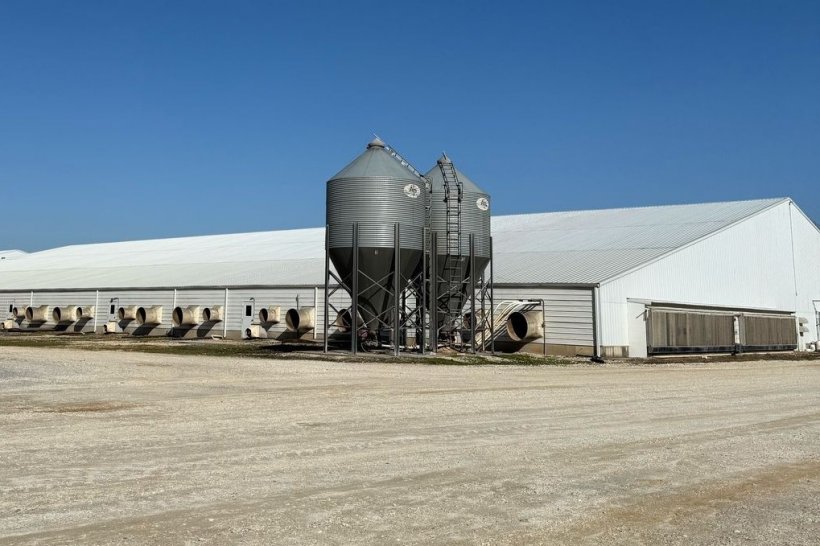The 333 Brazil team had the pleasure of attending a routine work day at one of the Tosh Pork sites in Tennessee, United States. The company stands out, not only for its swine production, but also for the important social role it plays in the region, which we will explore throughout this two-part series.
The company has 41,000 breeding sows distributed across nine farms, with capacities ranging from 2,500 to 8,000 sows. All of the farms operate under the farrow-to-wean production system, in which piglets are transferred to partner farms when they reach approximately three weeks of age. The genetic material used is supplied by the farm itself.

Tosh Pork also has a feed mill, which employs about 65 workers. The plant uses corn grown by Tosh Farms and local farmers, and produces approximately 7,000 tons of feed per week to supply its farms.
We visited a farm with 6,000 breeding sows, which has been operating for nine years (Figure 1).

Figure 1. One of the barns at the unit we visited.
Company culture
As is the case on most U.S. pig farms, piglets from the farm are weaned and transferred to other nursery farms. This phased production system was adopted years ago, mainly for sanitary reasons, especially due to the PRRS (porcine reproductive and respiratory syndrome) virus, which causes millions of dollars in losses annually in the U.S.
The company is family-run, has its own team, and an exclusive veterinarian to attend to the farm's health needs. He is responsible for diagnosing diseases, defining vaccination protocols, and monitoring and analyzing production indexes. In addition, this professional leads the unit's sustainability plan, one of the company's main pillars, focusing on the responsible use of antibiotics, animal welfare, and the fight against antimicrobial resistance.
In its feed formulation, as part of the company's sustainability strategy, and to reduce costs and increase productivity, by-products from large food chains are used, such as chocolate, pet food, and cookie scraps. The feed mill is automated, and the main feed presentation is in pellet form.
Workplace safety culture is also very important on the farm. Risk management training is provided regularly, especially on the safe handling of slurry pits and silos.
Over the past five years, the group has expanded its production capacity by around 20,000 breeding sows. To this end, in addition to leasing farms, the company also acquires properties.
Currently, half of the farms already run a group gestation system. The company's goal is to implement this model on all farms, aligning with international animal welfare standards.
Features of the farm's social program
The U.S., like other parts of the world, faces a major challenge due to labor shortages in the field, in addition to high staff turnover. However, on the farm the 333 Brazil team visited, the area supervisors at least have been with the company for a long time, which is especially beneficial for the consistency of management processes within production.
In social terms, this farm stands out for developing an important project aimed at the local community. People who are serving time or have debts to society are hired to work during the day. This program aims to support the social reintegration of these people and simultaneously address labor shortages. Interestingly, half of the participants in this project are women.
A particularly interesting point of this initiative is the incentive for these workers to have their own finishing farms in the future, after serving their sentences or legal obligations. Even if they do not remain employees of the company, they have the possibility of becoming business partners in the future.
Tosh Pork demonstrates a strong social commitment, investing not only in its employees but also in the surrounding community. With initiatives like this, the company, in addition to solving operational problems, promotes a positive social impact and real growth opportunities for all involved.

On-farm dynamics and the U.S. swine market
U.S. farms start their routines early: the workday begins at 6:00 a.m. and ends at 1:00 p.m. After that, no employees are on site, which is a very common practice in the country. For this model to work without compromising productivity, management must be extremely simple and efficient, as the farm remains unsupervised for much of the time. In the case of the farm visited, a night shift arrives at 5:00 p.m. and stays until midnight.
Regarding the production system, 70% of U.S. pork producers operate under an integration model, where integrators play a relevant role in the sector. Likewise, meat processing plants are concentrated and dominated by a few large companies.
The farm we visited markets the animals through a contract with JBS. The meat company guarantees the purchase of the production, and the producer guarantees the supply, a relationship that ensures predictability for both parties. This type of contract, revised annually, can be in force for several years.
The current situation in the U.S. swine market is challenging. For the past 18 months, producers have been operating at a loss. It is estimated that about 80,000 breeding sows leave the national herd each year, either due to a lack of generational succession or discouragement with the business.
On the management side, total outsourcing of farm management is a trend gaining momentum in the U.S. Specialized third-party companies are contracted to take care of everything: from the farm project, to day-to-day management to business succession. The idea is to provide professionalism in the technical aspects as well as in the transition from one generation to the next. Among the best-known companies operating in this model are Carthage and Pipestone.
Commitment to innovation and automation
The company has a clear vision of the swine industry's direction and recognizes the need to constantly invest in modernization and efficiency.
In addition to environmental control, which we will address in the next article, the farm we visited has important technological advances. One is the electronic feeding system in gestation, using electronic sow feeding (ESF) machines. The sow enters the station, which identifies her chip and automatically administers the exact amount of feed according to her individual consumption curve. This system, which has been in operation for nine years, has kept the sows in excellent body condition, with a score of 3 and 4 in most cases. The person in charge of the unit is quite satisfied with the results.
In the farrowing rooms, feeding is still done by volumetric dispensers, similar to those used in many parts of the world. However, the company is considering transitioning to electronic feeding for this phase as well.
Weaned piglets are counted by a camera system installed between the main farrowing room aisle and the loading area. As piglets pass through, the system automatically counts them with 99% accuracy, according to the farm manager. Due to the large production volume, there is no individual counting per sow.
An additional innovation that caught our attention was the cart used to transport the boar for heat detection. Controlled by remote control, it transports the boar in front of the females with the help of a single operator. This technology has made it possible to reduce the handling team for this task to a single person. It has also enabled the number of teaser boars to be halved, since the animals no longer tire as much from the repetitive process.
In this first article, we have presented the company's culture and guidelines and provided an overview of the U.S. market. In the next article, we will explore farm management in more depth.


